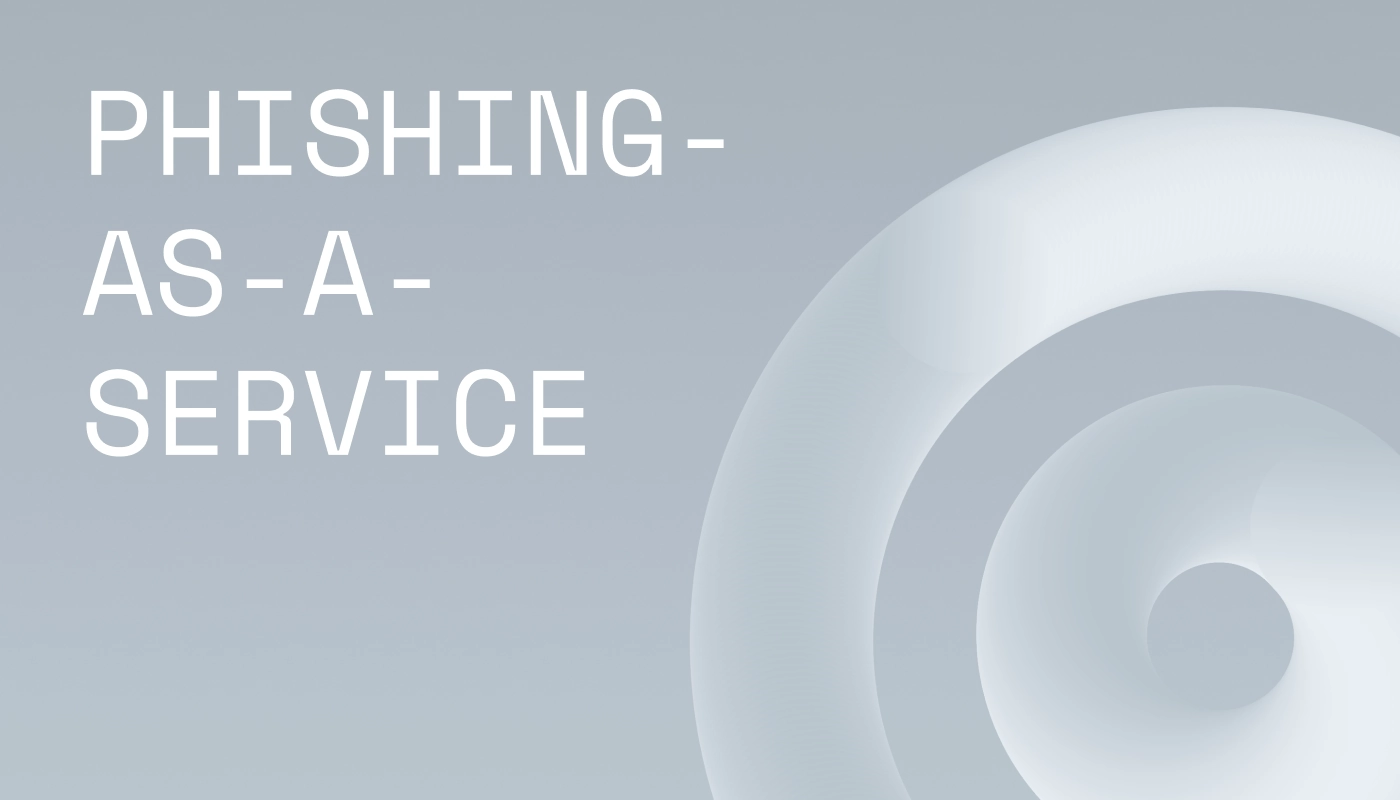NordStellar
Cybersecurity
Phishing-as-a-service: Tools, tactics, and risks for organizations

Summary: Phishing-as-a-service lets anyone launch advanced attacks using ready-made kits. Learn how it works, the risks it poses, and how to defend.
SaaS models have spread to the dark web, and that's a problem. Criminals can now buy or sell the technology needed to mount diverse cyberattacks, including large-scale phishing campaigns.
Phishing-as-a-service (PhaaS) is a critical cyber risk for all companies. Attacks that were once too complex for low-skill hackers now have an affordable price tag. This article will introduce how PhaaS works, what kits offer, and how to respond.
What is phishing-as-a-service (PhaaS) and who uses it?
Phishing-as-a-service allows unskilled cyber attackers to run phishing attacks by purchasing or renting advanced tools. PhaaS kits created by specialist developers enable novice attackers to build fake websites or send believable emails from trusted contacts.
Phishing-as-a-service streamlines phishing activities. Previously, threat actors needed to build websites, implant payloads, and research targets to create social engineering content. PhaaS provides ready-made phishing kits via familiar subscription models.
PhaaS emerged due to the rising demand for phishing technologies from professional criminal collectives and fraud rings. However, malicious insiders may also purchase and use PhaaS kits to damage their employers and steal sensitive data.
Common features offered in phishing kits
Phishing-as-a-service kits include the tools to contact, manipulate, and attack targets. Common elements of phishing kits include:
- Customizable templates. Developers include email templates or web pages from legitimate brands. Phishers can enter basic details for each target, or customize the content if needed. Advanced templates offer responsive designs for mobile devices and desktops, and may also include geolocation tools to tailor phishing emails and pages to different regions.
- Fake login pages. Developers create sites resembling portals for reputable brands (for instance, Google Mail). These phishing domains harvest login credentials from unsuspecting visitors. Advanced kits may include Captcha filters to add credibility.
- Data harvesting tools. Kits provide backend tools to harvest information from phishing pages and securely store exfiltrated data. Developers may offer encrypted storage via Telegram as a core function or an optional add-on.
- SMS spoofing tools. Kits allow users to send large quantities of SMS messages from seemingly trusted sources. This is particularly effective when phishers aim to capture one-time passwords and gain access to internal networks.
- Email spoofing tools. Spoofing allows phishers to bypass email security filters. Phishing tools create fake sender addresses that resemble legitimate contacts.
- Obfuscation tools. Phishing kits include tools to avoid detection by security systems or make analyzing phishing pages more complex. For example, kits may use URL redirection or content cloaking to avoid filters flagging sites as dangerous.
- Domain spoofing. Kits include tools to create fake websites that resemble legitimate versions. They may use homoglyphs or typosquatting to generate domains that contain spelling errors but superficially appear convincing.
- Analytics dashboards. Advanced phishing-as-a-service kits include dashboards to monitor key metrics. For example, analytics tools track click-through rates, rates of successful phishing attempts, and how often victims open malicious attachments. Dashboards may also enable A/B testing to fine-tune phishing techniques and help attackers work around security filters.
- Customer support/documentation. Some phishing-as-a-service vendors offer onboarding and operational assistance. Kits often feature step-by-step tutorials to evade security measures, research potential victims, and harvest stolen data.
- Authentication bypassing. Advanced kits like Tycoon 2FA use fake login portals and reverse proxies to create authentic sessions using intercepted credentials - potentially bypassing multi-factor authentication controls.
- Automatic updates. High-quality phishing kits automatically update tools to work around the latest anti-phishing software.
- Integrations. Phishing-as-a-service is part of a wider cybercrime ecosystem. For instance, phishing kits integrate with keyloggers and infostealers to gather information and enhance social engineering attacks.
Like standard SaaS, phishing-as-a-service kits provide everything users need to begin operations while minimizing the need for IT expertise. Developers sell flexible payment options, streamline tools for novices, ensure regular updates, and support customer queries.
How phishing-as-a-service is sold and distributed
Unlike traditional SaaS products, phishing-as-a-service kits are not easily available via the surface web. Buyers must venture into encrypted marketplaces to browse products and make purchases outside the scrutiny of law enforcement agencies.
PhaaS kits are commonly advertised on dark web marketplaces with intuitive UIs to browse kits and choose features. Cybercriminals may also purchase kits via encrypted messaging services. Telegram is a popular option due to its robust encryption and customization features.
As with SaaS marketplaces, buyers choose between payment methods to suit their ambitions and budgets. One-time kit purchases are generally possible, although phishers can save money with fixed-term subscriptions.
Payment is simple and secure via privacy-friendly cryptocurrencies. Profit sharing is also common, enabling affiliates to earn 20-30 percent commission from successful attacks. Affiliates also expand the market, making PhaaS available to a wider customer base.
How businesses can detect and stop phishing-as-a-service threats
The rise of phishing-as-a-service has widened the pool of potential threats. Even unskilled individuals can mount sophisticated phishing attacks using ready-made kits.
As more criminals embrace PhaaS, organizations are increasingly exposed to data breaches and financial fraud. Prevention measures are essential to detect phishers before they steal credentials and compromise your network.
Effective technical counter-measures to detect PhaaS include:
Email gateway filtering
Scanning emails at the network edge is a critical part of email security. Scanning tools block emails containing a known phishing link and detect suspicious attachments. Sophisticated tools leverage cyber threat intelligence to assess the reputation of sender IP addresses, delivering granular threat assessments.
Sandboxing
Quarantine high-risk emails in secure environments for assessment before delivery. Security teams check for malicious macros, script executions, and potential exploits. Sandboxed browsers visit suspicious links to verify whether they are connected to phishing attempts.
DMARC/SPF/DKIM
Use these email security protocols to verify sender identities and create secure connections with trusted accounts. SPF uses DNS records to detect and block spoofers. DKIM employs digital signatures to prevent tampering. DMARC monitors email connections and reports possible spoofing.
User Behavior Analytics (UBA)
Block phishing campaigns by detecting deviations from normal user behavior. Machine learning tools analyze normal behavior and detect unusual access patterns, timings, click frequency, and data manipulation. UBA helps detect compromised accounts that spread phishing emails internally.
Attack surface management
Attack surface management monitors potential vulnerabilities and fixes weak spots on the attack surface before phishing campaigns exploit them. For example, detecting and fixing exposed email servers, faulty access controls, or DNS configuration issues.
Phishing-as-a-service kits may include ways to bypass MFA or two-factor authentication. Don't be complacent about access controls, assuming one-time codes are sufficient. Evolving threats can work around authentication tools, and a proactive approach is vital.
Threat exposure management
Threat exposure management platforms like NordStellar proactively assess and mitigate phishing risks. Features include detecting and neutralizing cyber-squatting domains. Dark web monitoring also detects leaked credentials and mentions of your company, often a reliable motionthat attacks are in progress.
Remember: phishers target human weaknesses. They manipulate employees into taking risky actions, using urgent language and knowledge gained from careful research. The human element means that technical countermeasures are insufficient. Companies must improve their internal awareness and skills to make a real difference. Here are some ways to achieve that goal:
Security training and incident response
Robust training is critical to reducing phishing attack risks. Security teams must train all employees to identify phishers, whether they use email, SMS, or phone calls (vishing). Enforce the core message to trust no one and verify all external requests.
Educate network users to understand phishing techniques (urgent language, suspicious links, malicious attachments, spoofed addresses, and slight errors in email text). And encourage a culture of reporting. Make it easy to report suspicious phishing emails and to verify requests - even if they come from executives.
Phishing simulations
Phishing simulations back up training by showing how phishers operate in the wild. Inviting every staff member to phishing workshops may be impossible. However, try to integrate team leaders. Simulate multiple techniques to assess how well participants detect phishers and how quickly they respond.
Whaling awareness sessions
C-suite users tend to have extensive privileges and access to confidential information. Attackers assuming their identities can persuade junior colleagues to breach normal procedures. Executives often have the authority to make payments or loans, especially in the financial sector.
These facts make executives tempting targets for whaling attacks. Companies should prioritize high-level officers when designing training strategies, de-escalate unnecessary administrative privileges, and strictly implement Zero-Trust policies. There should be no exceptions for senior staff.
Final thoughts
Phishing-as-a-service has changed the rules of the game for tiny businesses and massive financial institutions alike.
In today's threat landscape, off-the-shelf phishing kits represent a serious and persistent threat. Low-skill threat actors can mount large-scale campaigns. Meanwhile, sophisticated vendors run corporate-style operations, offering regularly updated kits and flexible payment packages.
These developments mean that even small and mid-sized businesses are realistic targets for phishing attacks. Criminals don't need to invest in skills and technical planning. Developers do the hard work. Targets that used to be too small to bother with are now well within range.
What can you do? We recommend implementing a layered security strategy featuring threat monitoring platforms, technical controls, employee training, and swift incident responses.
At the same time, companies must remain vigilant and adaptable. PhaaS is not going away, and phishers can strike at any time. One-time defensive measures are not enough to counter a recurrent and constantly evolving threat.
Take action to protect against PhaaS threats. Contact the NordStellar team and adopt proactive threat management techniques today.








